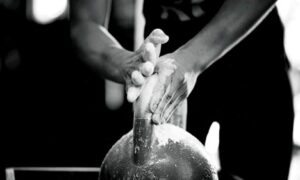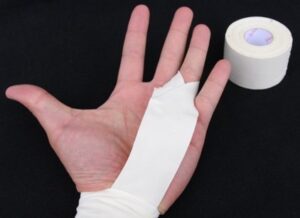Introduction

Welcome to this comprehensive guide where we’ll uncover the world of mastering callus-free kettlebell training. Kettlebells, known for their versatility in increasing strength and endurance, often come with a challenge – calluses. These rough patches of skin can hinder progress and temporarily disrupt your training routine. In this article, we’ll explore effective strategies for callus-free kettlebell training, ensuring your journey is as effective and comfortable as possible.
Table of Contents
Understanding Callus: Origin and Effects
Imagine yourself immersed in a tough kettlebell workout and pushing your limits to achieve your fitness goals. Gradually, you will start to see calluses forming on the sides of your palms and the base of your fingers. While these can be seen as symbols of dedication, they can also prove to be problematic if not taken care of. The key lies in mastering your technique, especially your grip. A firm grip, like the hook grip, which activates your finger flexors, plays an important role in reducing callus formation.
Strategically Using Gloves: Balancing Protection and Connection
Let’s talk about gloves – a common way to avoid calluses. Gloves provide a physical barrier, protecting your hands from the friction that leads to callus development. However, there is a subtle aspect to consider – the relationship between your central nervous system (CNS) and your movements. Progress in kettlebell training depends on efficient communication between these components. While gloves provide protection, relying solely on them can disrupt this essential CNS-movement connection. Interestingly, experienced athletes use gloves not only for protection but also to increase grip endurance. This technique can be a little slippery, but it also strengthens the muscles of the forearm over time.
The Technique to Master: The Key to Callus Prevention
At the core of effective strategies for callus-free kettlebell training lies the mastery of proper technique.
Take the kettlebell snatch, for example. Known for its dynamic nature, snatches can trigger callus formation due to repetitive motion. However, there’s no need to worry. Mastering the overhead drop technique is the gateway to success. Before getting into the snatch, make sure you’ve mastered this technique. Beyond that, maintaining fluid motion and impeccable form during your training sessions is paramount. A small but effective adjustment involves positioning your thumbs around the top knuckles of your index and middle fingers.
This simple change ensures an even appearance and greatly reduces the likelihood of calluses.
Proactive Measures: Dealing with Callus Challenges

In the field of callus management, the adage “prevention is better than cure” holds true. To anticipate and prevent blister-prone areas, arm yourself with two effective tools: medical tape and cotton fingerless gloves. Applying medical tape to potential problem areas acts as a preventive barrier against friction-induced discomfort. Alternatively, opting for cotton fingerless gloves provides protection while maintaining a tactile connection with your kettlebell. If blisters pop up unexpectedly during your session, consider a strategic approach. For one-handed snatching, changing hands can reduce the pressure on the affected areas. Similarly, if you’re doing an exercise with two kettlebells, a brief pause can prevent further burnout. This proactive approach not only saves you unnecessary downtime but also demonstrates your dedication to long-term training success.
Investing in Technical Mastery: Your Path to Callus-Free Success
Adopting technology as your ultimate ally in the callus battle requires investment—not only in terms of effort but also in terms of time and learning. Enrolling in workshops and training sessions that focus on mastering proper form can be of immense benefit. These platforms provide guided insight and practical exercises, ensuring that you have the knowledge and skills to execute kettlebell movements flawlessly. At EKFA (Example Kettlebell Fitness Academy), we are proud to provide online and offline L1 and L2 functional training and kettlebell workshops. These workshops are designed to advance your fitness journey, equip you with the tools to tackle challenges like calluses, and achieve optimal results. Our commitment to providing top-notch technology and comprehensive programs will enable you to achieve your fitness goals without the hindrance of calluses.
Conclusion: Empowerment through Strength and Comfort
In the journey to strength, endurance, and fitness excellence, kettlebell training stands out as a powerful tool. Through a holistic approach involving technique mastery, unwavering consistency and thoughtful preventive measures, you can overcome the callus challenge gracefully and embark on a seamless training journey. As we conclude, remember that our mission is to empower you to achieve kettlebell greatness with callus-free hands. Your road to strength and comfort begins right here – approach it with confidence, determination, and the promise of success.

